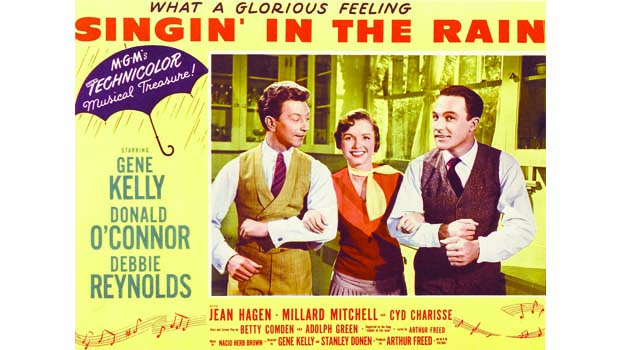Film Talk
Singin' in the Rain

James Berardinelli
Singin' in the Rain is considered by many people to be among the best Hollywood musicals of all time. For those who have seen the movie, the reason for this is not difficult to understand. Watching Singin' in the Rain is an exuberant, magical experience – a journey deep into the heart of feel-good territory. Sitting through the film's 102 minutes is like ingesting a mood-altering drug. It's the perfect antidote to the blues and the blahs, and a way to bolster, enhance, and extend a natural high.
Singin' in the Rain was produced during the height of the movie musical era, well after the genre had become established, but more than a decade before it began to run out of steam. In fact, only a few weeks before the world premiere, Gene Kelly's previous starring vehicle, An American in Paris, buzzed through the Oscars, winning six of the eight awards it was nominated for, including Best Picture. That Singin' in the Rain holds up so well today, more than 50 years after its first release, is a testament to the craftsmanship of the filmmakers and the athleticism of the performers.
Don Lockwood (Kelly) and Lina Lamont (Jean Hagen) are the darlings of the silver screen. They are so often paired romantically in movies that fans are convinced that their relationship extends beyond theaters. Lina, who isn't the brightest bulb in the package, in under the same impression – because she read it somewhere. Don, on the other hand, has little use for Lina except as a co-star. This is especially true once he meets and falls for the demure Kathy Selden (Debbie Reynolds), a chorus line girl who is Lina's opposite in almost every way that matters.
Although Singin' in the Rain is a lighthearted effort, it recalls genuine issues that arose in Hollywood during the late '20s, when many stars greatly feared the arrival of talking movies. Charles Chaplin, for example, was so distrustful of the talkies that he was still making silent films after virtually everyone else had capitulated with the new technology. (Chaplin's best, City Lights, was released almost four years after 1927's The Jazz Singer.) Many of the biggest stars were unable to make the transition, either because their style was unsuited to movies with sound, or because their voices made them laughable. Some of the incidents that occur on the set of The Dueling Cavalier are based on actual anecdotes related by crewmembers who had also participated in the early talkies.
Although Singin' in the Rain is best remembered for its musical aspects, it also works exceptionally well as comedy. The wit of Comden & Green's screenplay should not be underestimated. There are a number of laugh-aloud moments, and the dialogue contains several priceless one-liners. Don to Lina: "There is nothing between us. There has never been anything between us. Just air." Cosmo, about Lina: "She can't act, she can't sing, she can't dance. A triple threat." And Lina, about herself: "Why, I make more money than - than - than Calvin Coolidge, put together!" For me, the funniest moments come during the filming of the first talking scenes for The Dueling Cavalier, where the director can't figure out what to do with the microphone. (Watch for R.F.'s entrance.)
When it was first released in 1952, Singin' in the Rain received favorable (but not superlative) reviews and was moderately successful at the box office. It garnered only two Oscar nominations (Best Supporting Actress for Jean Hagen, Best Musical Score), neither of which it won. There seemed to be no reason to suppose that it would go down in history as one of the best of its genre. But time has been good to Singin' in the Rain, and, with the passage of years, audiences have grown to appreciate this as one of the most spellbinding examples of pure cinematic entertainment ever to unspool in a projector. For those who love musicals, nothing beats spending two hours in the company of Gene Kelly, Donald O'Connor, and Debbie Reynolds.




